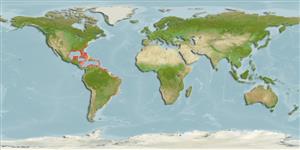Classification / Names
Common names from other countries
Main reference
Size / Weight / Age
Max length : 38.0 cm TL male/unsexed; (Ref. 5217); common length : 20.0 cm SL male/unsexed; (Ref. 188); max. published weight: 375.00 g (Ref. 5217)
Length at first maturity
Lm 11.5, range 11 - ? cm
Environment
Marine; reef-associated; depth range 1 - 50 m (Ref. 93252), usually 5 - ? m (Ref. 9710)
Climate / Range
Tropical, preferred 25°C (Ref. 107945); 41°N - 37°S, 98°W - 33°W (Ref. 188)
Distribution
Western Atlantic: Gulf of Maine (USA), Bermuda, throughout the Gulf of Mexico, Caribbean and West Indies southward to Santa Catarina, Brazil. The Colombian form is possibly a subspecies, Opisthonema oglinum captivai. Also found in Uruguay (Ref. 54736) and Argentina (Ref. 2806).
Countries | FAO areas | Ecosystems | Occurrences | Introductions
Short description
Dorsal
spines
(total): 0;
Dorsal
soft rays
(total): 19-21;
Anal
spines: 0;
Anal
soft rays: 23 - 24. The filamentous last dorsal fin ray distinguishes this species from all other western Atlantic clupeoids except Dorosoma, which has an inferior mouth (Ref. 188). Otherwise, superficially resembles species of Sardinella (but i 8 pelvic fin rays in western Atlantic species, cf. i 7 in Opisthonema) and Harengula (but small toothed hypomaxilla in upper jaw) (Ref. 188). Lower gill rakers stable at 28 to 46 after 8 cm (Ref. 188). Silvery, with a bluish or greenish back, 6-7 lengthwise dark streaks on side. Dark spot above opercle, larger dark spot behind opercle, usually with a row of dark spots behind it. Lower profile deeply curved. Head pointed (Ref. 7251).
IUCN Red List Status (Ref. 115185)
Threat to humans
Reports of ciguatera poisoning (Ref. 30911)
Human uses
Fisheries: commercial; bait: usually
Tools
Special reports
Download XML
Internet sources
Estimates of some properties based on models
Phylogenetic diversity index
PD50 = 0.5312 many relatives (e.g. carps) 0.5 - 2.0 few relatives (e.g. lungfishes)
Trophic Level
4.5 ±0.0 se; Based on diet studies.
Resilience
Medium, minimum population doubling time 1.4 - 4.4 years (tm=1-3; tmax=8)
Vulnerability
Low vulnerability (24 of 100)
Price category
